A Critical Review of Water Reuse: Lessons from Prehistoric Greece for Present and Future Challenges
Abstract
1. Introduction
2. Research Methodology
3. Water Reuse from Prehistoric to Medieval Era (ca 3200 BC–1400 AD)
3.1. Prehistoric Times (ca 3200–1100 BC)
3.2. Historical Times (ca 1100 BC–476 AD)
3.3. Medieval Times (ca 476–1400 AD)
4. Early and Mid-Modern Times (ca 1400–1900 AD)
5. Contemporary Times (ca 1900 AD-Present)
Relevance of Ancient Wastewater Management to Modern Times
6. Current Status of Water Reuse in Greece
The Case of Attica
7. Water Reclamation and Reuse-Trends and Challenges
- (a)
- Increased water availability and strengthened adaptation/resilience potential to climatic and/or seasonal variability, especially in vulnerable or water-stressed areas;
- (b)
- Improved agricultural productivity and improvement of urban green areas management, through fertigation practices (increased water and embedded nutrient supply);
- (c)
- Quantitative and qualitative protection of available water resources, preventing local over-exploitation and pollution;
- (d)
- Protection of groundwater resources in coastal areas by contrasting saltwater intrusion in coastal aquifers;
- (e)
- Increased water systems’ energy efficiency and reduction of GHG emissions;
- (f)
- Fulfillment of water users’ expectations by concerted support from concerned stakeholders.
7.1. Understanding and Quantifying Reuse
7.2. Modern Technology for Water Reuse Applications
7.3. Development of Water Reuse Criteria, Guidelines, and Regulations
8. Future Trends in Integrated Water and Wastewater Management
- (a)
- Comprehensive analysis of social, economic, and environmental issues (e.g., economic optimization and improvement of social welfare, water pricing, quality, and quantity), with the support of advanced analytical tools such as decision support systems [107];
- (b)
- Planning for water distribution networks resilience building to deliver water to users with minimal losses and interruptions [36];
- (c)
- (d)
- Promotion and adoption of efficient water use practices and technologies, supported by specific proactive actions such as motivation campaigns and financial/fiscal incentives [36];
- (e)
- Definition and exploitation of alternative sources, such as treated effluent and brackish/marginal waters, accompanied by supportive actions and policies, such as pricing and development of specific criteria covering all uses [39];
- (f)
- Specific actions targeted to the water-energy nexus (neutral or positive energy balance systems operation);
- (g)
- Consideration of water reuse as a key component of holistic water management in agreement with the “one water” concept and the circular economy process [109];
- (h)
- Promotion of public/private stakeholders dialogue and facilitation of knowledge transfer.
9. Epilogue
- (a)
- Feasibility studies concerning treated wastewater reuse with a focus on local environmental impact issues;
- (b)
- Full consideration of wastewater as a resource in the overall water budget, especially in urban and peri-urban areas;
- (c)
- Implementation of integrated water management frameworks for resilient and sustainable water supply, storm, and wastewater management;
- (d)
- Reuse options should be planned from the design phase of WWTPs, with criteria corresponding to the water needs in the surrounding area;
- (e)
- Policies, guidelines, and incentives for communities and businesses to encourage the most appropriate and cost-effective wastewater treatment solutions based on local capacities and reuse options should be adopted.
Author Contributions
Funding
Institutional Review Board Statement
Informed Consent Statement
Data Availability Statement
Acknowledgments
Conflicts of Interest
References
- Tzanakakis, V.E.; Koo-Oshima, S.; Haddad, M.; Apostolidis, N.; Angelakis, A.N. The History of Land Application and Hydroponic Systems for Wastewater Treatment and Reuse. In Evolution of Sanitation and Wastewater Management through the Centuries; Angelakis, A., Rose, J., Eds.; IWA Publishing: London, UK, 2014; Chapter 24; pp. 459–482. [Google Scholar]
- Tsagarakis, K.P.; Tsoumanis, P.; Chartzoulakis, K.; Angelakis, A.N. Water resources status including wastewater treatment and reuse in Greece: Related problems and prospectives. Water Int. 2001, 26, 252–258. [Google Scholar] [CrossRef]
- Mainardis, M.; Cecconet, D.; Moretti, A.; Callegari, A.; Goi, D.; Freguia, S.; Capodaglio, A.G. Wastewater fertigation in agriculture: Issues and opportunities for improved water management and circular economy. Environ. Pollut. 2021, 296, 118755. [Google Scholar] [CrossRef] [PubMed]
- EC. Water Reuse. 2022. Available online: https://ec.europa.eu/environment/water/reuse.htm#:~:text=At%20present%2C%20about%201%20billion,of%20annual%20EU%20freshwater%20withdrawals (accessed on 15 March 2023).
- EEA. European Environmental Agency. Data and Maps. 2019. Available online: https://www.eea.europa.eu/data-and-maps/figures/water-stress-in-europe/figure_4_3_3_left_graphic.eps (accessed on 15 March 2023).
- UN-WATER. Annual Report 2017; UN-Water Technical Advisory Unit: Geneva, Switzerland, 2018. [Google Scholar]
- UN-WATER. United Nations–Water. Wastewater: The Untapped Resource; United Nations Educational, Scientific and Cultural Organization: Paris, France, 2017. [Google Scholar]
- Capodaglio, A.G. Fit-for-purpose urban wastewater reuse: Analysis of issues and available technologies for sustainable multiple barrier approaches. Crit. Rev. Environ. Sci. Technol. 2021, 51, 1619–1666. [Google Scholar] [CrossRef]
- Capodaglio, A.G.; Callegari, A.; Molognoni, D. Online monitoring of priority and dangerous pollutants in natural and urban waters: A state-of-the-art review. Manag. Environ. Qual. Int. J. 2016, 27, 507–536. [Google Scholar] [CrossRef]
- Angelakis, A.N.; Asano, T.; Bahri, A.; Jimenez, B.E.; Tchobanoglous, G. Water reuse: From ancient to modern times and the future. Front. Environ. Sci. 2018, 6, 26. [Google Scholar] [CrossRef]
- Mosso, A. Escursioni nel Mediterraneo e gli Scavi di Creta; Treves: Milano, Italy, 1907. [Google Scholar]
- Gray, H.F. Sewerage in Ancient and Medieval Times. Sew. Work. J. 1940, 12, 939–946. Available online: http://sewerhistory.orgwww.sewerhistory.org/articles/whregion/1940_as201/article1.pdf (accessed on 20 January 2019).
- Koutsoyiannis, D.; Zarkadoulas, N.; Angelakis, A.N.; Tchobanoglous, G. Urban water management in Ancient Greece: Legacies and lessons. J. Water Resour. Plan. Manag. 2008, 134, 45–54. [Google Scholar] [CrossRef]
- Koutsoyiannis, D.; Angelakis, A. Hydrologic and Hydraulic Sciences and Technologies in Ancient Greek Times. In Encyclopedia of Water Science; CRC Press: Boca Raton, FL, USA, 2003; pp. 415–418. [Google Scholar]
- Angelakis, A.; Koutsoyiannis, D.; Tchobanoglous, G. Urban wastewater and stormwater technologies in ancient Greece. Water Res. 2005, 39, 210–220. [Google Scholar] [CrossRef] [PubMed]
- Antoniou, G.P.; Angelakis, A.N.; Mitchell, P. Latrines and wastewater sanitation technologies in ancient Greece. In Sanitation, Latrines and Intestinal Parasites in Past Populations; Ashgate Publishing: Surrey, UK, 2015; pp. 41–68. [Google Scholar]
- Yannopoulos, S.; Lyberatos, G.; Theodossiou, N.; Li, W.; Valipour, M.; Tamburrino, A.; Angelakis, A. Evolution of water lifting devices (pumps) through the centuries worldwide. Water 2015, 7, 5031–5060. [Google Scholar] [CrossRef]
- Kalavrouziotis, I.K.; Koukoulakis, P.H.; Drakatos, P.A. Water and wastewater management in antiquity in the context of an ethically oriented environmental protection. Int. J. Glob. Environ. Issues 2015, 14, 226–237. [Google Scholar] [CrossRef]
- Angelakis, A.N.; Rose, J.B. Evolution of Sanitation and Wastewater Technologies through the Centuries; IWA Publishing: London, UK, 2014. [Google Scholar]
- Schladweiler, J.C. Tracking down the Roots of Our Sanitary Sewers. 2002. Available online: https://ascelibrary.org/doi/10.1061/40641%282002%2958 (accessed on 15 March 2023).
- Burian, S.J.; Edwards, F.G. Historical Perspectives of Urban Drainage. In Proceedings of the 9th International Conference on Urban Drainage, ASCE, Portland, OR, USA, 12 July 2022. [Google Scholar] [CrossRef]
- Arden, E.; Lockett, W.T. They Discovered the Activated Sludge Process. Historia Sanitaria. 1914. Available online: https://www.wiki.sanitarc.si/1914-w-t-lockett-discovered-activated-sludge-process/ (accessed on 15 March 2023).
- Metcalf; Eddy, I.; Asano, T.; Burton, F.L.; Leverenz, H.; Tsuchihashi, R.; Tchobanoglous, G. Water Reuse; McGraw-Hill Professional Publishing: New York, NY, USA, 2007. [Google Scholar]
- Jimenez, B.; Asano, T. Water Reuse: International Survey of Current Practice, Issues and Needs, Scientific and Technical Report No. 20; IWA Publishing: London, UK, 2008. [Google Scholar]
- Lazarova, V.; Asano, T.; Bahri, A.; Anderson, J. Milestones in Water Reuse—The Best Success Stories; IWA Publishing: London, UK, 2013; p. 408. ISBN 9781780400075. [Google Scholar]
- Jewell, W.J.; Seabrook, B.L. A history of Land Application as a Treatment Alternative. 1979. Available online: https://www.epa.gov/biosolids/history-land-application-treatment-alternative (accessed on 15 March 2023).
- Angelakis, A.N.; Capodaglio, A.G.; Dialynas, E.G. Wastewater Management: From Ancient Greece to Modern Times and Future. Water 2022, 15, 43. [Google Scholar] [CrossRef]
- Capodaglio, A.G. Critical perspective on advanced treatment processes for water and wastewater: AOPs, ARPs, and AORPs. Appl. Sci. 2020, 10, 4549. [Google Scholar] [CrossRef]
- US-EPA. Guidelines for water reuse. In Special Restricted Crop Area in Mendoza, Argentina; US-EPA: Washington, DC, USA, 2012. [Google Scholar]
- Jones, E.R.; Van Vliet, M.T.; Qadir, M.; Bierkens, M.F. Country-level and gridded estimates of wastewater production, collection, treatment and reuse. Earth Syst. Sci. Data 2021, 13, 237–254. [Google Scholar] [CrossRef]
- EEA. A Blueprint to Safeguard Europe’s Water Resources. Communication From The Commission to The European Parliament, The Council, The European Economic and Social Committee and The Committee of The Regions /* COM/2012/0673 final */; European Environment Agency: Copenhagen, Denmark, 2012. [Google Scholar]
- Forum, G.W. NEWater in Singapore. National University of Singapore. 2018. Available online: https://globalwaterforum.org/2018/01/15/newater-in-singapore/ (accessed on 15 March 2023).
- Maksimovic, C.; Tejada-Guibert, J.A. Urban Water Management—Deadlock or Hope; IWA Publishing: London, UK, 2001. [Google Scholar]
- Crouch, D.P. Water Management in Ancient Greek Cities; Oxford University Press: New York, NY, USA, 1993. [Google Scholar]
- Tzanakakis, V.; Angelakis, A.; Paranychianakis, N.; Dialynas, Y.; Tchobanoglous, G. Challenges and Opportunities for Sustainable Management of Water Resources in the Island of Crete, Greece. Water 2020, 12, 1538. [Google Scholar] [CrossRef]
- Tzanakakis, V.A.; Paranychianakis, N.V.; Angelakis, A.N. Water Supply and Water Scarcity. Water 2020, 12, 2347. [Google Scholar] [CrossRef]
- Water, S.S.F. Treatment of Wastewater; Hellenic Ministry of Environment and Energy: Athens, Greece, 2017. [Google Scholar]
- Stavropoulou, S.C. Analysis of Water Costs in Greek Agriculture and Its Spatial Variations, According to the River Basin Management plans; Engineering School, Aristotle University of Thessaloniki: Thessaloniki, Greece, 2020. [Google Scholar]
- Paranychianakis, N.; Salgot, M.; Snyder, S.; Angelakis, A. Quality criteria for recycled wastewater effluent in EU-countries: Need for a uniform approach. Crit. Rev. Environ. Sci. Technol. 2015, 45, 1409–1468. [Google Scholar] [CrossRef]
- CMD. Common Ministerial Decision. In Measures, Limits and Procedures for Reuse of Treated Wastewater; No. 145116; Ministry of Environment, Energy and Climate Change: Athens, Greece, 2011. (In Greek) [Google Scholar]
- EU. EU Regulation 2020/741 of the European Parliament and of the council of 25 May 2020 on minimum requirements for water reuse. Off. J. Eur. Union 2020, L 177/32. [Google Scholar]
- EC-COM. European Commission. Communication from the Commission to the European Parliament, the Council and the European Economic and Social Committee, European Union Strategic Approach to Pharmaceuticals in the Environment; (COM(2019) 128 final); European Commission: Brussels, Belgium, 2019. [Google Scholar]
- Menegaki, A.N.; Hanley, N.; Tsagarakis, K.P. The social acceptability and valuation of recycled water in Crete: A study of consumers’ and farmers’ attitudes. Ecol. Econ. 2007, 62, 7–18. [Google Scholar] [CrossRef]
- EU. EU-Level Instruments on Water Reuse: Final Report to Support the Commission’s Impact Assessment; EU: Brussels, Belgium, 2016; Available online: https://ec.europa.eu/environment/water/blueprint/pdf/EU_level_instruments_on_water-2nd-IA_support-study_AMEC.pdf (accessed on 15 March 2023).
- Papadopoulou, A.; Stefanakou, G.; Fougias, E. Promotion of environmental projects to conform with UWWTD and integrated water management. Water Pract. Technol. 2022, 17, 1421–1432. [Google Scholar] [CrossRef]
- Baloutsos, G.; Rousos, A. Identification and Verification of Extreme Droughts in Greece from the 14th to the 19th Century—Their Contribution to the Adaptation of Corresponding Potential Phenomena during the 21st century (In Greek). Dasarxeio. Com. 2020. Available online: https://dasarxeio.com/2020/06/26/82686/ (accessed on 15 March 2023).
- US-EPA. Water Reuse Research; EPA: Washington, DC, USA, 2023. Available online: https://www.epa.gov/water-research/water-reuse-research (accessed on 15 March 2023).
- Ormerod, K.J.; Scott, C.A. Drinking wastewater: Public trust in potable reuse. Sci. Technol. Hum. Values 2013, 38, 351–373. [Google Scholar] [CrossRef]
- Tchobanoglous, G.; Kenny, J.; Leverenz, H. Rationale for constant flow to optimize wastewater treatment and advanced water treatment performance for potable reuse applications. Water Environ. Res. 2021, 93, 1231–1242. [Google Scholar] [CrossRef] [PubMed]
- Peterson, E.S.; Summers, R.S. Removal of effluent organic matter with biofiltration for potable reuse: A review and meta-analysis. Water Res. 2021, 199, 117180. [Google Scholar] [CrossRef] [PubMed]
- Tang, C.Y.; Yang, Z.; Guo, H.; Wen, J.J.; Nghiem, L.D.; Cornelissen, E. Potable water reuse through advanced membrane technology. Environ. Sci. Technol. 2018, 52, 10215–10223. [Google Scholar] [CrossRef]
- Lautze, J.; Stander, E.; Drechsel, P.; da Silva, A.K.; Keraita, B. Global experiences in water reuse. In CGIAR Research Program on Water, Land and Ecosystems (WLE); International Water Management Institute (IWMI): Colombo, Sri Lanka, 2014; Volume 31. [Google Scholar]
- Chitikela, S.R.; Gullapalli, V.; Ritter, W.F. Treated and Regulated Effluents of the US Municipal Wastewater to Making Direct Potable Reuse (DPR). In Proceedings of the World Environmental and Water Resources Congress 2019: Water, Wastewater, and Stormwater; Urban Water Resources; and Municipal Water Infrastructure, Pittsburgh, PA, USA, 19–23 May 2019; pp. 211–221. [Google Scholar] [CrossRef]
- Kehrein, P.; van Loosdrecht, M.; Osseweijer, P.; Garfí, M.; Dewulf, J.; Posada, J. A critical review of resource recovery from municipal wastewater treatment plants–market supply potentials, technologies and bottlenecks. Environ. Sci. Water Res. Technol. 2020, 6, 877–910. [Google Scholar] [CrossRef]
- Tchobanoglous, G.; Leverenz, H. Comprehensive Source Control for Potable Reuse. Front. Environ. Sci. 2019, 7. [Google Scholar] [CrossRef]
- Tortajada, C. Contributions of recycled wastewater to clean water and sanitation Sustainable Development Goals. NPJ Clean Water 2020, 3, 22. [Google Scholar] [CrossRef]
- Stathatou, P.-Μ.; Gad, F.-K.; Kampragou, E.; Grigoropoulou, H.; Assimacopoulos, D. Treated wastewater reuse potential: Mitigating water scarcity problems in the Aegean islands. Desalination Water Treat. 2015, 53, 3272–3282. [Google Scholar] [CrossRef]
- Zafeirakou, A.; Karavi, A.; Katsoulea, A.; Zorpas, A.; Papamichael, I. Water resources management in the framework of the circular economy for touristic areas in the Mediterranean: Case study of Sifnos Island in Greece. Euro-Mediterr. J. Environ. Integr. 2022, 7, 347–360. [Google Scholar] [CrossRef]
- Angelakis, A.N.; Dercas, N.; Tzanakakis, V.A. Water Quality Focusing on the Hellenic World: From Ancient to Modern Times and the Future. Water 2022, 14, 1887. [Google Scholar] [CrossRef]
- Furlong, C.; Jegatheesan, J.; Currell, M.; Iyer-Raniga, U.; Khan, T.; Ball, A.S. Is the global public willing to drink recycled water? A review for researchers and practitioners. Util. Policy 2019, 56, 53–61. [Google Scholar] [CrossRef]
- Copetti, D.; Marziali, L.; Viviano, G.; Valsecchi, L.; Guzzella, L.; Capodaglio, A.; Tartari, G.; Polesello, S.; Valsecchi, S.; Mezzanotte, V. Intensive monitoring of conventional and surrogate quality parameters in a highly urbanized river affected by multiple combined sewer overflows. Water Supply 2019, 19, 953–966. [Google Scholar] [CrossRef]
- Karthik, V.; Selvakumar, P.; Kumar, P.S.; Satheeskumar, V.; Vijaysunder, M.G.; Hariharan, S.; Antony, K. Recent advances in electrochemical sensor developments for detecting emerging pollutant in water environment. Chemosphere 2022, 304, 135331. [Google Scholar] [CrossRef] [PubMed]
- Tan, D.T.; Shuai, D. Research highlights: Antibiotic resistance genes: From wastewater into the environment. Environ. Sci. Water Res. Technol. 2015, 1, 264–267. [Google Scholar] [CrossRef]
- Kang, M.; Yang, J.; Kim, S.; Park, J.; Kim, M.; Park, W. Occurrence of antibiotic resistance genes and multidrug-resistant bacteria during wastewater treatment processes. Sci. Total Environ. 2022, 811, 152331. [Google Scholar] [CrossRef]
- Rodriguez-Mozaz, S.; Vaz-Moreira, I.; Varela Della Giustina, S.; Llorca, M.; Barceló, D.; Schubert, S.; Berendonk, T.U.; Michael-Kordatou, I.; Fatta-Kassinos, D.; Martinez, J.L.; et al. Antibiotic residues in final effluents of European wastewater treatment plants and their impact on the aquatic environment. Environ. Int. 2020, 140, 105733. [Google Scholar] [CrossRef]
- Yang, Y.; Song, W.; Lin, H.; Wang, W.; Du, L.; Xing, W. Antibiotics and antibiotic resistance genes in global lakes: A review and meta-analysis. Environ. Int. 2018, 116, 60–73. [Google Scholar] [CrossRef]
- Malakar, A.; Snow, D.D.; Ray, C. Irrigation water quality—A contemporary perspective. Water 2019, 11, 1482. [Google Scholar] [CrossRef]
- Voutsa, D.; Hartmann, P.; Schaffner, C.; Giger, W. Benzotriazoles, alkylphenols and bisphenol A in municipal wastewaters and in the Glatt River, Switzerland. Environ. Sci. Pollut. Res. Int. 2006, 13, 333–341. [Google Scholar] [CrossRef]
- Arditsoglou, A.; Voutsa, D. Partitioning of endocrine disrupting compounds in inland waters and wastewaters discharged into the coastal area of Thessaloniki, Northern Greece. Environ. Sci. Pollut. Res. Int. 2010, 17, 529–538. [Google Scholar] [CrossRef]
- Ghernaout, D.; Ibn-Elkhattab, R.O. Drinking Water Reuse: One-Step Closer to Overpassing the “Yuck Factor”. Open Access Libr. J. 2019, 6, 1. [Google Scholar] [CrossRef]
- Capodaglio, A.G. In-stream detection of waterborne priority pollutants, and applications in drinking water contaminant warning systems. Water Sci. Technol. Water Supply 2017, 17, 707–725. [Google Scholar] [CrossRef]
- Sanz, M.A. Trends in Desalination & Water Reuse. Desalination and Water Reuse Business Forum. Enhancing Climate Resilience for Cities. Singapore International Water Week. 2018. Available online: https://www.siww.com.sg/docs/default-source/default-document-library/mr-miguelsanz.pdf?sfvrsn=2 (accessed on 15 March 2023).
- Cecconet, D.; Callegari, A.; Hlavínek, P.; Capodaglio, A.G. Membrane bioreactors for sustainable, fit-for-purpose greywater treatment: A critical review. Clean Technol. Environ. Policy 2019, 21, 745–762. [Google Scholar] [CrossRef]
- Capodaglio, A.G.; Callegari, A. Domestic wastewater treatment with a decentralized, simple technology biomass concentrator reactor. J. Water Sanit. Hyg. Dev. 2016, 6, 507–510. [Google Scholar] [CrossRef]
- Water Research Foundation. Optimizing Carbon-Based Advanced Treatment for Potable Reuse. 2020. Available online: https://www.waterrf.org/news/optimizing-carbon-based-advanced-treatment-potable-reuse (accessed on 15 March 2023).
- Cecconet, D.; Sturini, M.; Malavasi, L.; Capodaglio, A.G. Graphitic carbon nitride as a sustainable photocatalyst material for pollutants removal. State-of-the art, preliminary tests and application perspectives. Materials 2021, 14, 7368. [Google Scholar] [CrossRef]
- Capodaglio, A.G. Contaminants of emerging concern removal by high-energy oxidation-reduction processes: State of the art. Appl. Sci. 2019, 9, 4562. [Google Scholar] [CrossRef]
- Capodaglio, A.G.; Bojanowska-Czajka, A.; Trojanowicz, M. Comparison of different advanced degradation processes for the removal of the pharmaceutical compounds diclofenac and carbamazepine from liquid solutions. Environ. Sci. Pollut. Res. 2018, 25, 27704–27723. [Google Scholar] [CrossRef]
- Trojanowicz, M.; Bojanowska-Czajka, A.; Szreder, T.; Męczyńska-Wielgosz, S.; Bobrowski, K.; Fornal, E.; Nichipor, H. Application of ionizing radiation for removal of endocrine disruptor bisphenol A from waters and wastewaters. Chem. Eng. J. 2021, 403, 126169. [Google Scholar] [CrossRef]
- Trojanowicz, M.; Bartosiewicz, I.; Bojanowska-Czajka, A.; Szreder, T.; Bobrowski, K.; Nałęcz-Jawecki, G.; Męczyńska-Wielgosz, S.; Nichipor, H. Application of ionizing radiation in decomposition of perfluorooctane sulfonate (PFOS) in aqueous solutions. Chem. Eng. J. 2020, 379, 122303. [Google Scholar] [CrossRef]
- Pazda, M.; Kumirska, J.; Stepnowski, P.; Mulkiewicz, E. Antibiotic resistance genes identified in wastewater treatment plant systems—A review. Sci. Total Environ. 2019, 697, 134023. [Google Scholar] [CrossRef]
- Gerrity, D.; Owens-Bennett, E.; Venezia, T.; Stanford, B.D.; Plumlee, M.H.; Debroux, J.; Trussell, R.S. Applicability of ozone and biological activated carbon for potable reuse. Ozone Sci. Eng. 2014, 36, 123–137. [Google Scholar] [CrossRef]
- Bengtsson-Palme, J.; Hammarén, R.; Pal, C.; Östman, M.; Björlenius, B.; Flach, C.-F.; Fick, J.; Kristiansson, E.; Tysklind, M.; Larsson, D.G.J. Elucidating selection processes for antibiotic resistance in sewage treatment plants using metagenomics. Sci. Total Environ. 2016, 572, 697–712. [Google Scholar] [CrossRef]
- Capodaglio, A.G.; Olsson, G. Energy issues in sustainable urban wastewater management: Use, demand reduction and recovery in the urban water cycle. Sustainability 2019, 12, 266. [Google Scholar] [CrossRef]
- Tow, E.W.; Hartman, A.L.; Jaworowski, A.; Zucker, I.; Kum, S.; AzadiAghdam, M.; Blatchley, E.R.; Achilli, A.; Gu, H.; Urper, G.M.; et al. Modeling the energy consumption of potable water reuse schemes. Water Res. X 2021, 13, 100126. [Google Scholar] [CrossRef] [PubMed]
- Capodaglio, A.G.; Bolognesi, S.; Cecconet, D. Sustainable, decentralized sanitation and reuse with hybrid nature-based systems. Water 2021, 13, 1583. [Google Scholar] [CrossRef]
- Cecconet, D.; Bolognesi, S.; Piacentini, L.; Callegari, A.; Capodaglio, A.G. Bioelectrochemical greywater treatment for non-potable reuse and energy recovery. Water 2021, 13, 295. [Google Scholar] [CrossRef]
- US-EPA. Guidelines for Water Reuse; U.S. Agency for International Development: Washington, DC, USA; US Environmental Protection Agency: Washington, DC, USA, 2004. [Google Scholar]
- US-EPA. Water Reuse Resources; U.S. Agency for International Development: Washington, DC, USA, 2022. [Google Scholar]
- Partyka, M.L.; Bond, R.F. Wastewater reuse for irrigation of produce: A review of research, regulations, and risks. Sci. Total Environ. 2022, 828, 154385. [Google Scholar] [CrossRef] [PubMed]
- Shoushtarian, F.; Negahban-Azar, M. Worldwide Regulations and Guidelines for Agricultural Water Reuse: A Critical Review. Water 2020, 12, 971. [Google Scholar] [CrossRef]
- EC-COM. European Commission. Communication from the Commission to the European Parliament, the Council, the European Economic and Social Committee and the Committee of the Regions, Chemicals Strategy for Sustainability Towards a Toxic-Free Environment (COM(2020) 667 Final); European Commission: Brussels, Belgium, 2020. [Google Scholar]
- EC-COM. Euroopean Commission. Communication from the Commission to the European Parliament, the Council, the European Economic and Social Committee and the Committee of the Regions, Pathway to a Healthy Planet for All EU Action Plan: ‘Towards Zero Pollution for Air, Water and Soil’ (COM/2021/400 final); European Commission: Brussels, Belgium, 2021. [Google Scholar]
- EC-COM. European Commision. Proposal for a Directive of the European Parliament and of the Council Concerning Urban Wastewater Treatment (Recast)(COM(2022) 541 Final; European Commission: Brussels, Belgium, 2022. [Google Scholar]
- EC-COM. European Commission. Communication from the Commission to the European Parliament, the Council, the European Economic and Social Committee and the Committee of the Regions. Towards a comprehensive European Union Framework on Endocrine Disruptors; European Commission: Brussels, Belgium, 2018; Available online: https://ec.europa.eu/transparency/documents-register/detail?ref=COM(2018)734&lang=en (accessed on 15 March 2023).
- EC-C. Commisision Implementing Decision of 19.1.2022. Establishing a Watch List of Substances and Compounds of Concern for Water Intended for Human Consumption as Provided for in Directive (EU) 2020/2184 of the European Parliament and of the Council (C(2022) 142 Final); European Commission: Brussels, Belgium, 2022. [Google Scholar]
- Anastopoulos, I.; Pashalidis, I.; Kayan, B.; Kalderis, D. Microplastics as carriers of hydrophilic pollutants in an aqueous environment. J. Mol. Liq. 2021, 350, 118182. [Google Scholar] [CrossRef]
- Li, J.; Zhang, K.; Zhang, H. Adsorption of antibiotics on microplastics. Environ. Pollut. 2018, 237, 460–467. [Google Scholar] [CrossRef]
- Spyridakis, I.; Tzanakakis, V.A.; Pashalidis, I.; Kalderis, D.; Anastopoulos, I. Polyamide nylon 6 as a potential carrier of nitrate anions in aqueous environments. J. Mol. Liq. 2022, 352, 118706. [Google Scholar] [CrossRef]
- Obermaier, N.; Pistocchi, A. A Preliminary European-Scale Assessment of Microplastics in Urban Wastewater. Front. Environ. Sci. 2022, 10, 917. [Google Scholar] [CrossRef]
- Enfrin, M.; Dumée, L.F.; Lee, J. Nano/microplastics in water and wastewater treatment processes–origin, impact and potential solutions. Water Res. 2019, 161, 621–638. [Google Scholar] [CrossRef]
- Gong, J.; Xie, P. Research progress in sources, analytical methods, eco-environmental effects, and control measures of microplastics. Chemosphere 2020, 254, 126790. [Google Scholar] [CrossRef]
- Li, J.; Song, Y.; Cai, Y. Focus topics on microplastics in soil: Analytical methods, occurrence, transport, and ecological risks. Environ. Pollut. 2020, 257, 113570. [Google Scholar] [CrossRef] [PubMed]
- Zhou, Y.; Wang, J.; Zou, M.; Jia, Z.; Zhou, S.; Li, Y. Microplastics in soils: A review of methods, occurrence, fate, transport, ecological and environmental risks. Sci. Total Environ. 2020, 748, 141368. [Google Scholar] [CrossRef]
- Tchobanoglous, G.; Stensel, H.D.; Burton, F. Wastewater Engineering: Treatment and Reuse, 4th ed.; McGraw-Hill Education: New York, NY, USA, 2003. [Google Scholar]
- Howarth, W. Going with the flow: Integrated Water Resources Management, the EU Water Framework Directive and ecological flows. Leg. Stud. 2018, 38, 298–319. [Google Scholar] [CrossRef]
- Candido, L.A.; Coêlho, G.A.G.; de Moraes, M.M.G.A.; Florêncio, L. Review of Decision Support Systems and Allocation Models for Integrated Water Resources Management Focusing on Joint Water Quantity-Quality. J. Water Resour. Plan. Manag. 2022, 148, 03121001. [Google Scholar] [CrossRef]
- Pereira, M.A.F.; Barbieiro, B.L.; Quevedo, D.M.d. Importance of river basin monitoring and hydrological data availability for the integrated management of water resources. Soc. Nat. 2022, 32, 292–303. [Google Scholar]
- EC-COM. European Commission. From the Commission to the European Parliament, the Council, the European Economic and social Committee and the Committee of the Regions on the Implementation of the Circular Economy Action Plan (190 Final); European Commission: Brussels, Belgium, 2019; Available online: https://environment.ec.europa.eu/strategy/circular-economy-action-plan_en (accessed on 15 March 2023).
- CMD. Common Ministerial Decision. In Management Plan as a River Basin of the Water Region of Crete; No 163. ΦΕΚ 570/B’/2015; Ministry of Environment, Energy and Climate Change: Athens, Greece, 2015. (In Greek) [Google Scholar]
- CMD. Common Ministerial Decision. In Management Plan as a River Basin of the Water Region of Crete; No 896, ΦΕΚ Β/4666/2017; Ministry of Environment, Energy and Climate Change: Athens, Greece, 2017. (In Greek) [Google Scholar]
- Rancher, R.S.; Tchobanoglous, G. The Opportunities and Economics of Direct Potable Reuse; WaterReuse Res. Foundation: Alexandria, VA, USA, 2014. [Google Scholar]

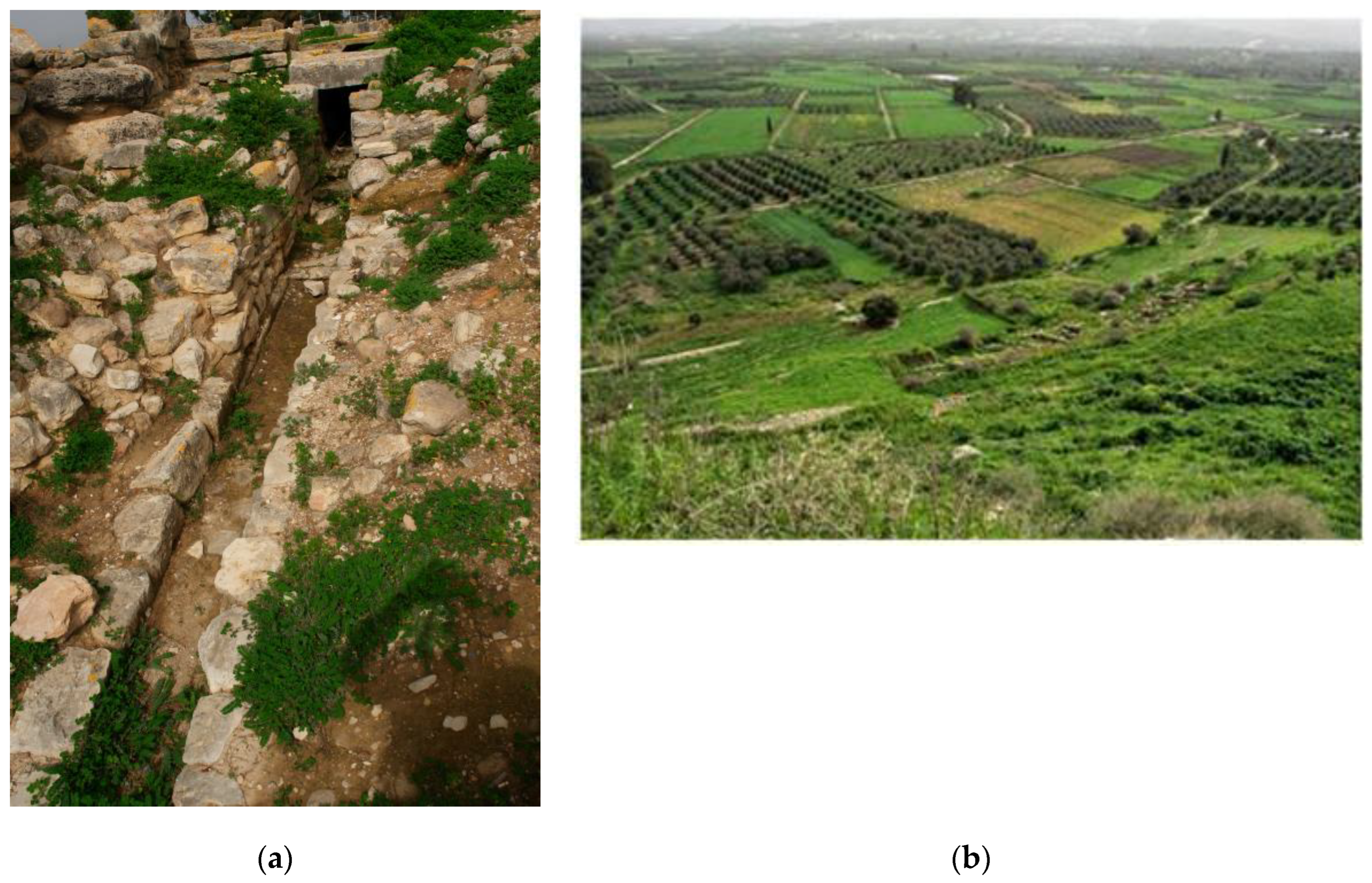
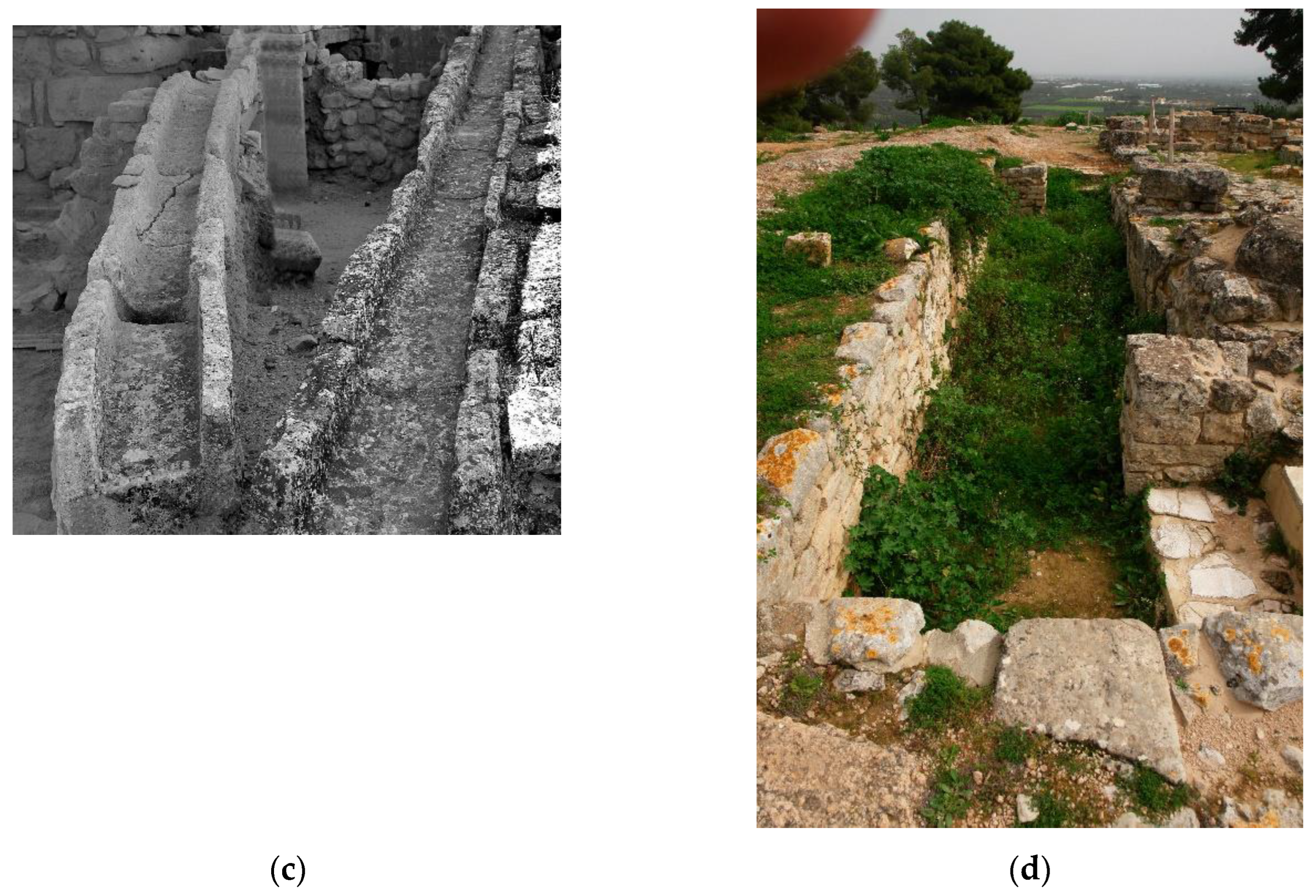
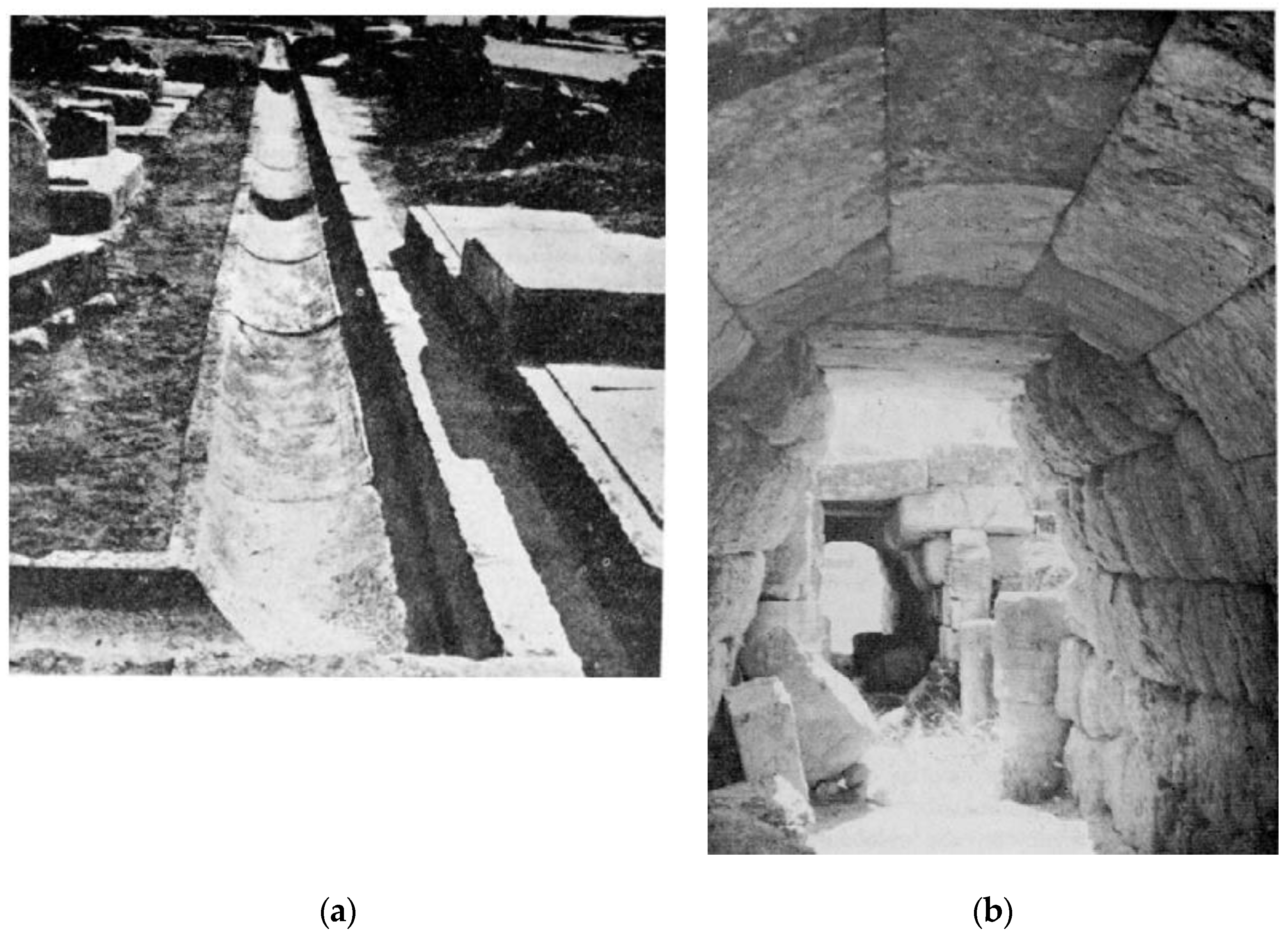
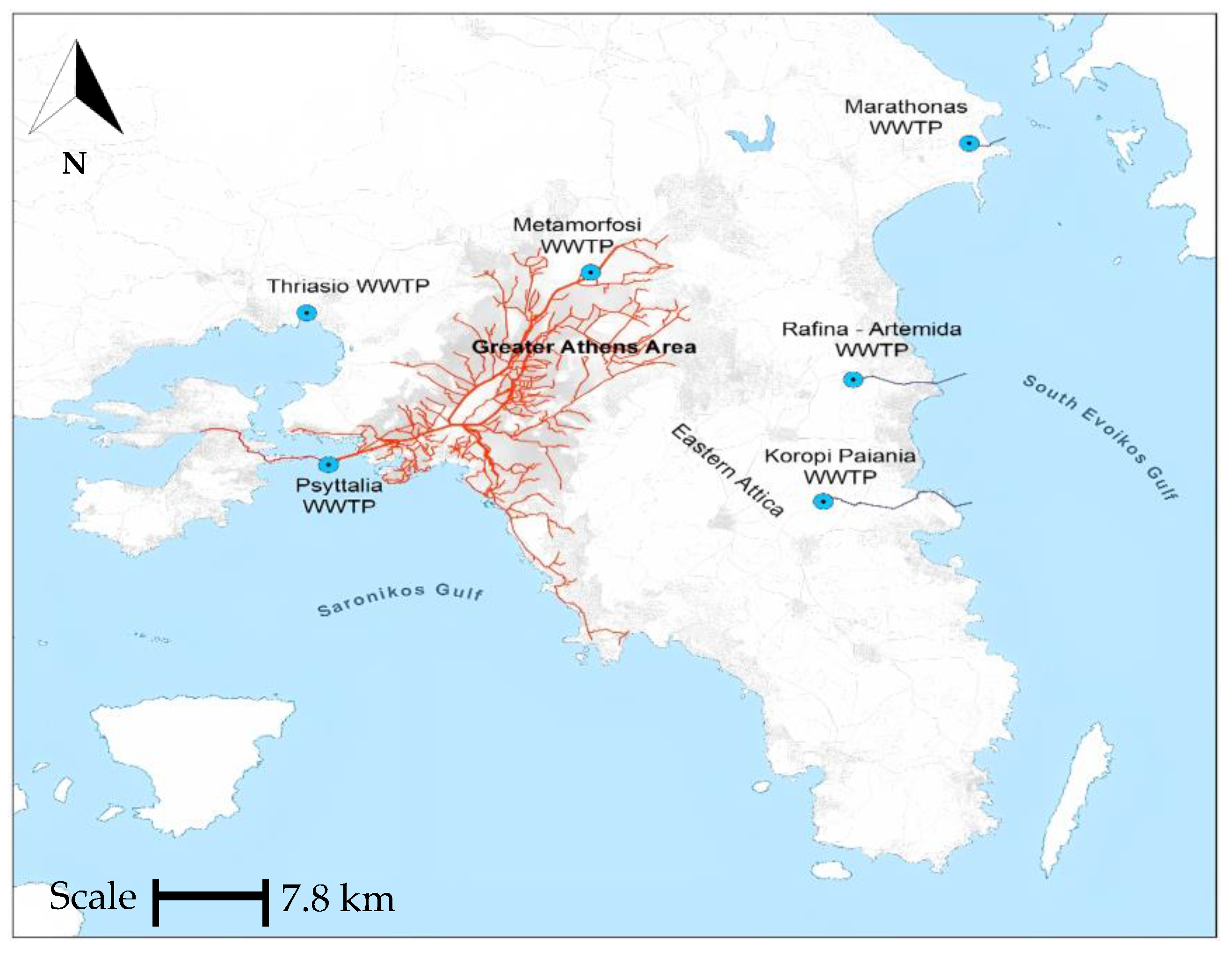
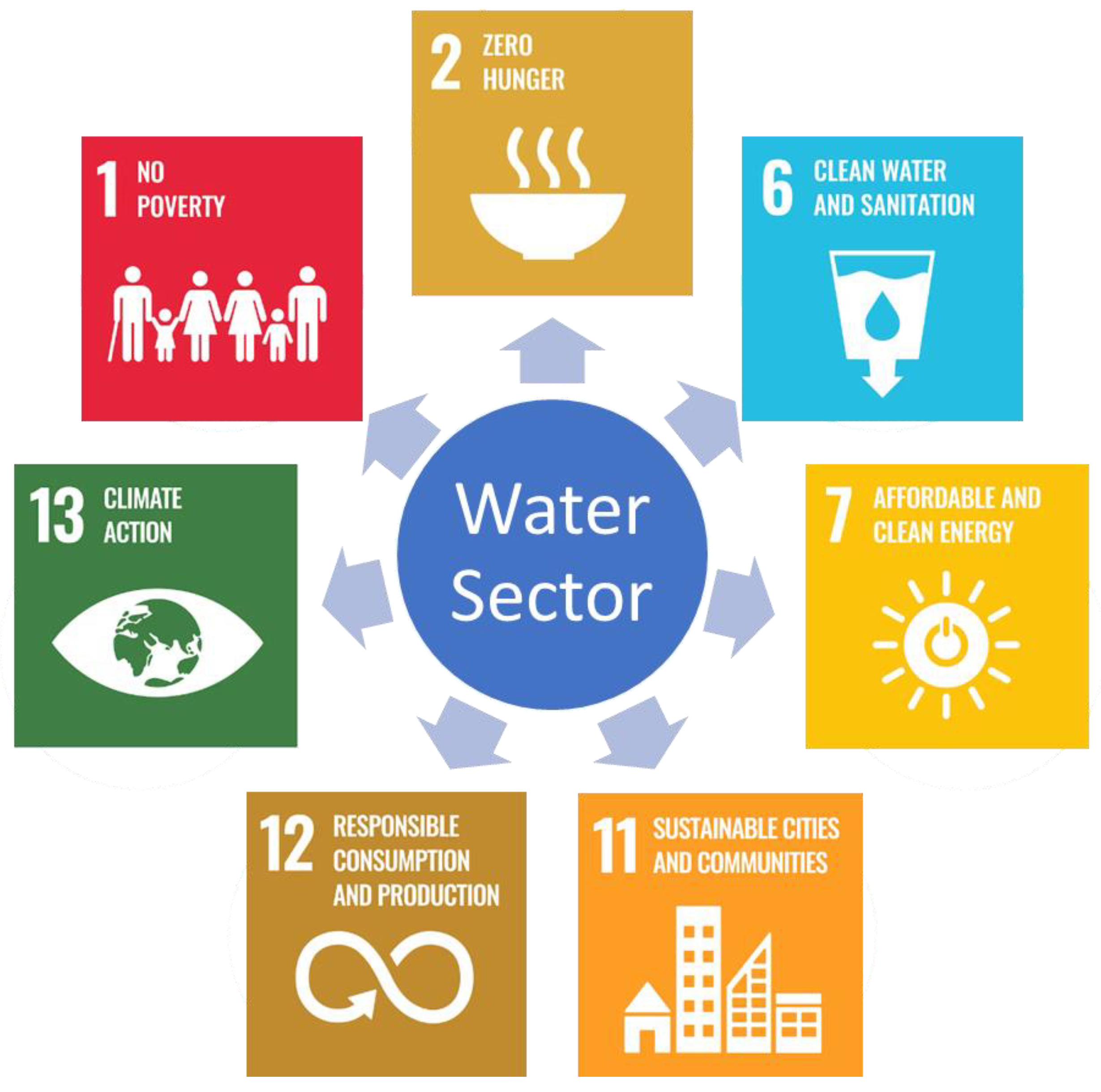
| Region | Countries | Reuse Volume (km3) | Applications | Examples | |
|---|---|---|---|---|---|
| 1. | North America | USA, Canada | 9.2 | DPR IPR Recreation Environmental Irrigation Municipal Industrial Various reuses | Orange County; Big Spring, TX, and Nevada; Arizona, Pomona, Los Angeles, CA, and Nevada; Commercial buildings in British Columbia and Toronto Healthy House; Refineries, Power plants Monterrey, Nuevo Leon, Mexico |
| 2. | South America | Argentina, Brazil, Chile, Colombia, Mexico, Peru | 2.1 | Irrigation Municipal | Mezquital Valley and Caribbean Islands; Road and monuments washing in Sau Paulo and Fortaleza, Brazil |
| 3. | Europe | Spain, Cyprus, Germany, Belgium, Malta, Greece, Italy, France | 6.7 | Environmental Recreational Agricultural | Aquifer recharge; Golf course irrigation; Sant Antonin sewage treatment plant (Malta) |
| 4. | Middle East and Africa | Israel, Egypt, Namibia, Kuwait, Tunisia, Ghana, Ethiopia, Saudi Arabia, Jordan South Africa, | 7.7 | DPR IPR Irrigation | Windhoek (Namibia); Tel-Aviv, Dan region; Agricultural and landscape irrigation in Tunisia; Durban Water recycling plant, South Africa |
| 5. | Asia Pacific | Japan, China, India, Hong Kong, Singapore, South Korea, Australia | 15 | IPR Municipal Agricultural Industrial Recreational | NEWater Singapore; Toilet flushing (Shinjuku, Tokyo, Kitakyushu, and Tokai regions); Virginia Pipeline Project Adelaide, Australia; Oil refineries in Geelong (Victoria); Kwinana Water Reclamation Plant |
| 6. | Russia | Moscow, Vladivostok, St. Petersburg | 1 | Industrial | Oil Refineries |
| Population Served (Range) | WWTPs (n) | Capacity (hm3/yr) | Reused (hm3/yr) | Possible Reuse Type | Comments |
|---|---|---|---|---|---|
| <2000 | 250 | 8.50 | 2.80 | Agricultural irrigation | Additional small projects (˃3300), serving ˂2000 persons in various stages of planning and development (when completed, they will serve about 22% of the total Greek population) |
| 2000–5000 | 70 | 47.00 | 1.30 | Agricultural and landscape irrigation | |
| 5000–15,000 | 95 | 167.00 | 2.50 | Agricultural and landscape irrigation and groundwater recharge | Under construction: Palaiochora/Chania, Neapoli/Lasithi, Palaicastro (Sitias)/ Lasithi |
| 15,000–100,000 | 66 | 320.00 | 3.00 | IPR, agricultural and landscape irrigation, and groundwater recharge | New plants in Koropi-Paiania and Marathon |
| 100,000–150,000 | 4 | 30.00 | 0.75 | Agricultural and landscape irrigation | Larisa, Rafina-Artemida, Ioannina, Katerini, Chania |
| >150,000 | 7 | 370.00 | 0.60 | IPR, agricultural And landscape irrigation, and groundwater recharge | Psyttalia, Metamorfosis, Thriasio, Patra, Rodos, Thessaloniki, Iraklio, and Volos |
| Total | 492 | 942.50 a | 10.95 b,c |
Disclaimer/Publisher’s Note: The statements, opinions and data contained in all publications are solely those of the individual author(s) and contributor(s) and not of MDPI and/or the editor(s). MDPI and/or the editor(s) disclaim responsibility for any injury to people or property resulting from any ideas, methods, instructions or products referred to in the content. |
© 2023 by the authors. Licensee MDPI, Basel, Switzerland. This article is an open access article distributed under the terms and conditions of the Creative Commons Attribution (CC BY) license (https://creativecommons.org/licenses/by/4.0/).
Share and Cite
Angelakis, A.N.; Tzanakakis, V.A.; Capodaglio, A.G.; Dercas, N. A Critical Review of Water Reuse: Lessons from Prehistoric Greece for Present and Future Challenges. Water 2023, 15, 2385. https://doi.org/10.3390/w15132385
Angelakis AN, Tzanakakis VA, Capodaglio AG, Dercas N. A Critical Review of Water Reuse: Lessons from Prehistoric Greece for Present and Future Challenges. Water. 2023; 15(13):2385. https://doi.org/10.3390/w15132385
Chicago/Turabian StyleAngelakis, Andreas N., Vasileios A. Tzanakakis, Andrea G. Capodaglio, and Nicholas Dercas. 2023. "A Critical Review of Water Reuse: Lessons from Prehistoric Greece for Present and Future Challenges" Water 15, no. 13: 2385. https://doi.org/10.3390/w15132385
APA StyleAngelakis, A. N., Tzanakakis, V. A., Capodaglio, A. G., & Dercas, N. (2023). A Critical Review of Water Reuse: Lessons from Prehistoric Greece for Present and Future Challenges. Water, 15(13), 2385. https://doi.org/10.3390/w15132385











